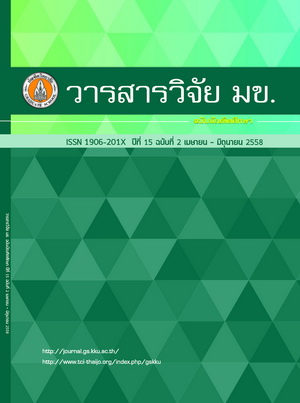Molecular Docking and Anti-acetylcholinesterase Activity of (N-(1-benzyl-1H-1,2,3-triazol-4yl)methyl)-4-hydroxy-3-methoxycinnamamide ( โมเลกุลาร์ด๊อกกิ้งและฤทธิ์การยับยั้งอะซิทิลโคลีนเอสเทอเรสของสาร (N-(1-benzyl-1H-1,2,3-triazol-4yl)methyl)-4-hydroxy-3-me
Keywords:
Triazolyl feruloyl amide, Anti-cholinesterase, Molecular dockingAbstract
ABSTRACT
Ferulic acid, a phenolic compound is found in a variety of fruits and vegetables. Ferulic acid has antioxidant activity, anti-inflammation and inhibition of β-amyloid fibrils formation. Thus, derivative of ferulic acid has gained much interest in drug discovery for treatment of neurodegenerative diseases. Recently, triazolyl feruloyl amide derivatives were synthesized in our laboratory. It was found that (N-(1-benzyl-1H-1, 2, 3-triazol-4yl) methyl)-4-hydroxy-3-methoxycinnamamide (compound 4a) produce a good inhibitory activity for Aβ1-42 aggregation. In this study, the inhibitory activity of compound 4a for electric eel acetylcholinesterase (EeAChE) and equine serum butyrylcholiesterase (eqBuChE) were evaluated and donepezil was used as a reference. Compound 4a was selective inhibitor for EeAChE as compared to eqBuChE. However, compound 4a shows less potent (IC50 255.85 mM), as compared to donepezil (IC50 0.01 mM) for inhibition of EeAChE. From results of molecular docking, compound 4a interacted with dual binding sites: catalytic anionic site (CAS) residues Trp86 and His447; and peripheral anionic site (PAS) residue Trp286 in the binding cavity of EeAChE. The nature of binding between compound 4a and EeAChE were mainly π–π and π–cation interactions. Moreover, compound 4a also bound into the hydrophobic pocket of EeAChE. Our study found that compound 4a was worthy for further investigation and development for treatment of Alzheimer’s disease.
บทคัดย่อ
กรดเฟอรูลิคเป็นสารฟีโนลิคที่พบในผลไม้และผักหลากหลายชนิด กรดเฟอรูลิคมีฤทธิ์ต้านออกซิเดชัน ต้านการอักเสบและยับยั้งการสร้างเบต้าอะไมลอยด์ไฟบริล ดังนั้นอนุพันธ์ของกรดฟูเลอริคจึงได้รับความสนใจมากในการค้นพบยาสำหรับรักษาโรคที่เกิดจากความเสื่อมของระบบประสาท เมื่อเร็วๆ นี้อนุพันธ์ไทรอะโซลิลเฟอรูโลอิลเอไมด์ ได้ถูกสังเคราะห์ในห้องปฏิบัติการของเรา พบว่า (N-(1-benzyl-1H-1,2,3-triazol-4yl)methyl)-4-hydroxy-3- methoxycinnamamide (สาร 4a) แสดงฤทธิ์ยับยั้งการเกาะกลุ่มของ Aβ1-42 ที่ดี ในการศึกษานี้ ฤทธิ์ยับยั้งของสาร 4a ต่อเอนไซม์อะซิทิลโคลีนเอสเทอเรสจากปลาไหลไฟฟ้า (EeAChE) และบิวทีริลโคลีนเอสเทอเรสจากเซรั่มม้า (eqBuChE)ได้ถูกประเมินและโดเนเพซิลถูกใช้เป็นสารอ้างอิง สาร 4a เป็นสารยับยั้งที่จำเพาะต่อ EeAChE เมื่อเทียบกับ eqBuChE อย่างไรก็ตามสาร 4a มีความแรง (IC50 255.85 mM) น้อยกว่าเมื่อเทียบกับโดเนเพซิล (IC50 0.01 mM) ในการยับยั้ง EeAChE จากผลของโมเลกุลาร์ด๊อกกิ้ง สาร 4a เกิดอันตรกิริยากับกรดอะมิโนในโพรงการจับของ EeAChE ในสองตำแหน่ง คือ Trp86 และ His447 ใน catalytic anionic site (CAS) และ Trp286 ใน peripheral anionic site (PAS) การจับกันระหว่างสาร 4a และ EeAChE เป็นอันตรกิริยาชนิด π–π และ π–cation นอกจากนี้สาร 4a ยังจับกับโพรง hydrophobic ของ EeAChE การศึกษานี้พบว่าสาร 4a มีความน่าสนใจที่จะนำมาศึกษาและพัฒนาต่อไปเพื่อการรักษาโรคอัลไซเมอร์



